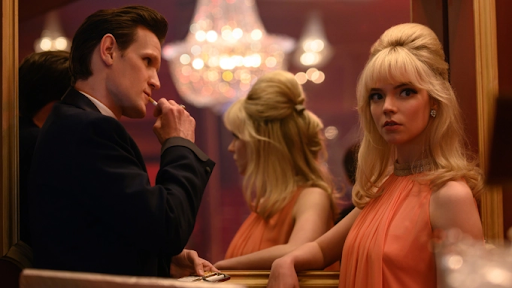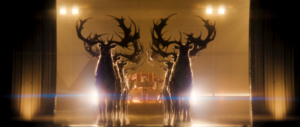Last Night in Soho is a Disjointed Tale of Deadly Nostalgia

Image courtesy of Parisa Taghizadeh/Focus Features
By Noelia Veras
Charming and sinister, Last Night in Soho is a complex tale that largely employs paradoxical storytelling to portray the main character, Elosie’s, desires and fears. Eloise, or Ellie, played by Thomasin McKenzie, is an aspiring fashion designer who leaves her rural home to study in London where her late mother also studied fashion.
The film was directed by Edgar Wright, who is famous for his critically acclaimed films Scott Pilgrim vs the World (2010) and Baby Driver (2017). It premiered in theaters on October 29, 2021. The film tackles heavy topics such as suicide and sexual assault, so viewer discretion is advised.
The film has a sheen of the uncanny from the moment it begins as we are introduced to the endearing Ellie who dances in a dress made of newspapers to music from the 60s, but when she glances in her mirror we see an image of her dead mother. The dialogue alludes to some special abilities that she might possess that enable her to see her dead mother, but it is not explained in depth. The first act of the movie, then, does hold flecks of the absurd but maintains the tone and mood of a coming-of-age film with a pleasant protagonist who has lofty dreams.
However, the tone shifts significantly when Ellie has a strange and visceral dream of the talented but undiscovered singer Sandy, played by Anya Taylor-Joy, from the 1960s. Even the color grading and tonalities of the film shift.
Asa Shoul, the senior colorist at Warner Bros., worked on the color grading of the film and described the process of “creating eras through tone shifts” in the film to Variety.
“The grading software we use is so powerful that the look of a film can be greatly changed after shooting,” Shoul said. “Ideally the lighting, set design, costume, and makeup will go some way in defining the cinematographers’ vision for the film, but many would like to retain the ability to change this during the grade.”
The film effortlessly moves between different periods and hints at the change in time through a shift in wardrobe along with other elements of the mise-en-scene. For example, fashion is distinctly different in the two eras. In Ellie’s time we see Y2K inspired outfits, street style, and the eccentric patterns and style associated with the current fashion while Sandy’s time is more high-brow and shows off A-line, flowy, sophisticated dresses and well-fitted suits.
The shift in era is a convention deeply woven into the film’s nostalgia-ridden homage to the entertainment industry in the 1960s. The dazzling and sparkling wonder of the parts of the movie that take place in the 60s are a facade, a cover for the sinister nature of the industry, which is littered with corruption, discrimination, manipulation, and exploitation.
The film’s sharpest turn occurs during a bloody and disjointed climax. Prior to the climax, the momentum of the movie was marked with brilliance, patience, and suspense. However, what follows are the remains of a critically important message that is tainted by a feverish need to entertain and shock audiences rather than move them.
Despite the absurd and disappointing third act, the performances from Taylor-Joy and McKenzie are masterful and surely the best part of the film.
Last Night in Soho is certainly not a failure, though, and captures Wright’s desire to tell a story that warns audiences to be wary of romanticizing nostalgia.
“Inspired by his parents’ stories of growing up in the 60s, Wright pitched Last Night in Soho as a love letter to that particular time and space,” according to The Hindu. “However, he also wanted it to be a cautionary tale of the danger of romanticizing the past.”
Ultimately, the film is fun for the first two acts and, in its entirety, it is definitely unique with stunning visuals and impressive editing and filming.





